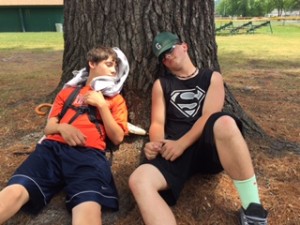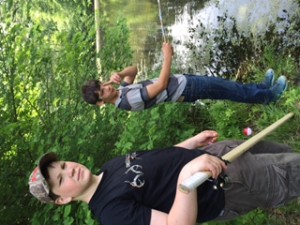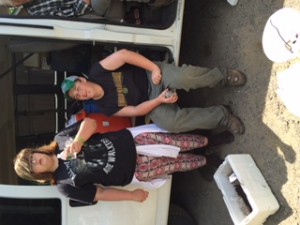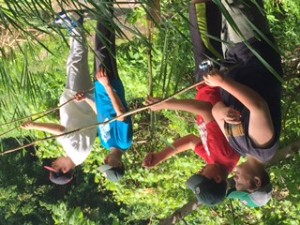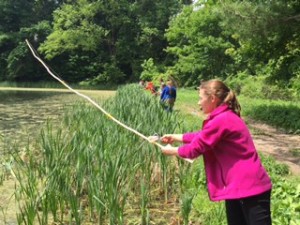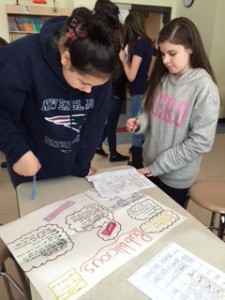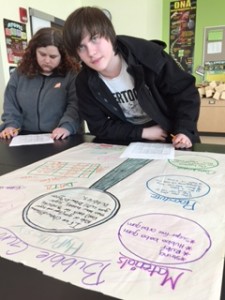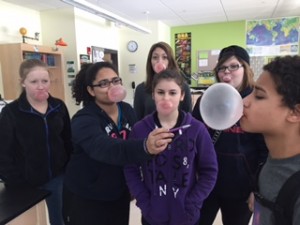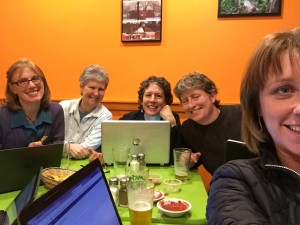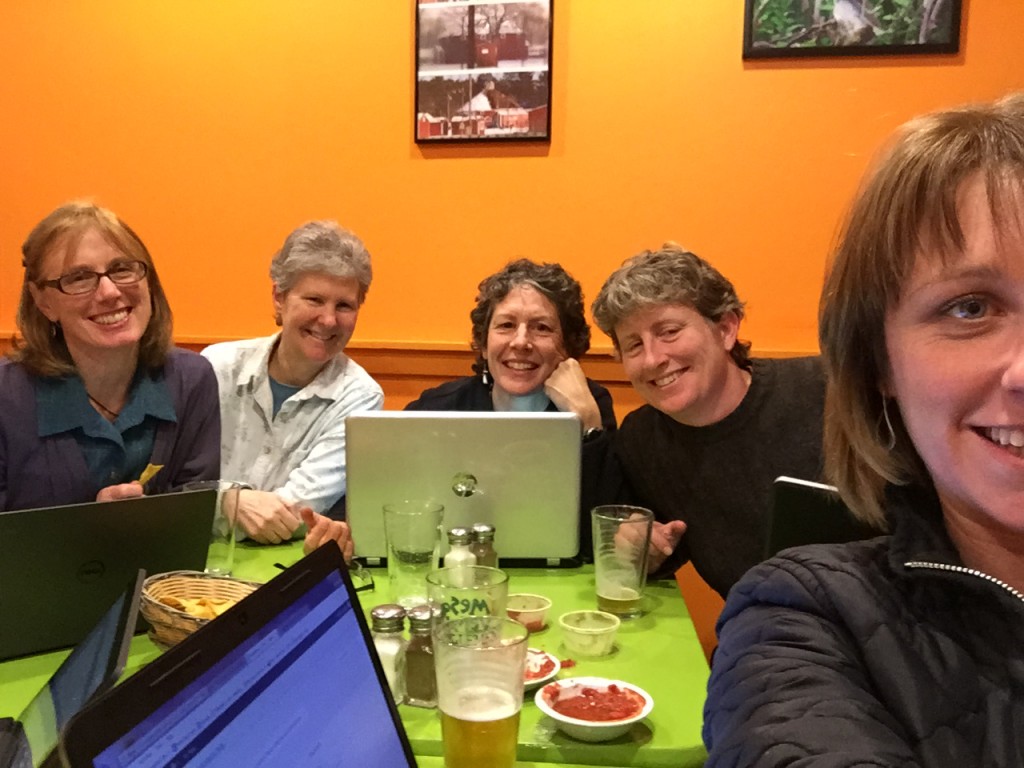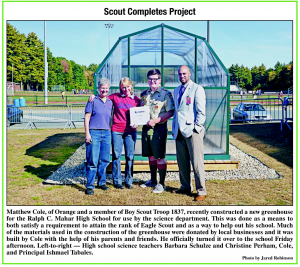- Thanks to input from other s2tlc participants I was able to refine my Action Research Project focus so it was not “slanted” toward a specific outcome (assuming that there would be a positive impact as a result of crew at Sullivan).
- Update on my COP in relation to student learning: Thanks to HPS “fuller” school day there is now time available during the school day once a week where I can physically meet with my vertical team within my building. For years we have worked have consistent formats and methods through grade levels to facilitate student familiarity with expectations within the math classrooms. It hasn’t been until we have had this sacred time available every week coupled with the flexibility of the google platform and the ability to co-author academic products that we have been able to jointly develop, streamline, and put to use from 6th-8th grade common rubriks for writing EBQ’s (responses to evidence based questions with thorough but concise supporting evidence), stream line daily warm ups to assess previous day learning, exit tickets (to make students aware of the goal for the end of the class period), weekly spiral homework assignments(that tie in previous standards that support the new standard being taught for the week).
- My VCOP continues to expand: I keep in touch with Keith Wright and one of his former colleagues to support our crew work at Sullivan, I look to Andrea Cooley Strom and appreciate the support from Sandy and Deatrice’s perspectives from Zoom experience, as well as on-going virtual contact with Lori Banks (my rock), Tom Wyze and Jeremiah Barrett as he sends me his former students from time to time. I could not make it through this journey in isolation. I also am working to familiarize myself with the google platform and its version of Skype or Zoom so as to start a virtual classroom across our district in upcoming school year where my students can learn from 7th grade students in other Holyoke buildings and would like to further expand their experiences to interact with other districts across the state or country as well empowering them as communicators.
- Crew: my pet project continues albeit with some blips in the radar due to the different levels of dedication/comfort of different grade levels and staff members. As I have mentioned, I knew this would be our biggest challenge. We were told that we would be given sacred time to develop lesson plans for crew to be shared in order to lighten the load of adding this to our daily responsibilities. As the year went on this was not made possible, for which I take responsibility. I should have fought for it more. At the end of the year the 8th grade team has “time” available after step up that could be dedicated to this end.
Action Research “Crew: Supporting Growth Mindset”
References
- Panorama Survey
- Angela Duckworth “Grit”
- “Mindset” Carol S. Dweck
- Renaissance High School“Crew” manual (collection)
Methodology:
- Through daily structured crew, students build relationships with each other and adult to explore confidence building activities with support of their peers
- Grit Test, Academic scores, observation of personal growth by teachers that had them last year and looped with them again this year.
- Research plan is to quantitatively evaluate student response to united plan to perpetuate growth mindset across content areas and grade levels.
- Survey students and teachers in regards to their experiences with new approach to supporting growth mindset learning/teaching. (districtwide/schoolwide Panorama Survey results available upon request)
- Partnership with Amherst College Athletics.
Data Collection and Analysis:
- Since the onset of the school year, different crews have stepped up and built relationships and become positive role models to the kids in the younger grades by mentoring them in weekly projects/activities. This has greatly changed the building atmosphere.
- Crews have also taken on responsibilities within the building as a way to give back to our unsung hero staff (cafeteria and custodial workers).
- Results from Panorama Survey are in! Students having greater sense of school belonging (up 9% from last year)
- 88% of students feeling safe in their classrooms (up 11)
- 73% of students feel it is possible to change their level of intelligence.
- 68% of students surveyed believe it is possible to change how they behave in class and change giving a lot of effort.
- Teacher-student relationships up 7% to 61% favorable since last survey.
- Next steps for next year include: Increase “Grit”. students fell 4% on the Grit scale (perserverence)
- Ability to self manage: students admit they lack ability to pay attention and resist distractions.
- Partnership with Amherst CollegeDiversity & Inclusion/Director of Club Sports, continues to connect Amherst College student athletes with middle school students..
Recommendations and Conclusions:
- Have you faced any unforeseen challenges?
- Absolutely, not everyone was “on board” at on set of Crew project and it has morphed into different things for different age-level crews. I would have liked to see more consistency from 6-8th grades but it is still a work in process.
- Do you anticipate additional challenges?
- At least my data (and our school’s Panorama Survey results) supports the work we are doing but with an uncertain future at HPS the question arises to, will there be sacred time daily to meet as crews? If not, how can we continue in other ways to support growth mindset in an on-going, thoughtful, and united way with our middle school students? It does appear that with a consistent connection between advisors and their crews, and amongst crew members students feel more connected to their school community. What we have experienced as teachers is an increased willingness by students to take academic risks in the classroom and for teachers to be even more willing to further extend themselves to the emotional and academic support of their students due to their deepened relationships with their crew members especially.
- Do you see any cool opportunities to partner, etc.? I’d like to expand into a virtual classroom connecting with students in other districts or classes within our own district, empowering our students to showcase their talents. I’d like to use virtual classroom, during crew time, to invite in experts in different fields of interest for our students to interact with as well.
Cultural Reflections on Urban Ed
Cultural Reflections on Urban Ed
Two new books out about teaching highlight the challenges and opportunities around urban education. One, called The Battle for Room 314: My Year of Hope and Despair in a New York City High School documents how its author, Ed Boland, a former administrator at an educational access program, crashed and burned as a first year teacher. Nicole Dixon, herself a NYC public school teacher since 2009, notes in her review that the book is rather stereotypical of the urban school genre—it glorifies the many challenges that urban students face as well as their challenging behaviors. In doing so, the book misses a number of important story lines that also occur in urban schools, but are often ignored by mainstream media.
First, teaching anywhere is quite challenging. I remember my first year teacher as a science teacher. I was a scientist, and so I figured it would be easy to teach science. I had no teacher training and had not been in a classroom in over twenty years. My first lesson plan, which I prepared five minutes before students arrived, was not even a lesson—I simply wrote on the board that students were to read the first 50 pages of their text book and answer any questions they encountered.
My utter lack of experience made for a very long year for both the students and myself, and I left teaching during my second year to take a job administering a grant. However, unlike Mr. Boland, I went back into teaching and now am an award-winning teacher. Even with several awards under my belt, I am still growing as a teacher. Teaching is a challenging craft, yet urban districts often end up hiring the teachers who are least prepared to teach. Many do not last very long. They either make all their mistakes in the urban district and then take their hard-won experience to a district with more resources, or they leave teaching entirely. However, it is important to note that most urban schools have some stalwarts that hang in there year after year and who positively impact students’ lives.
And what lives these are! Another storyline that Ed Boland misses is a crucial one—students in urban schools can and do learn. They can think critically, and they can create masterfully written essays, stories, poems, and lab reports. They can impact their societies through civic engagement, perform wonders on the stage, and they can do all of this even as they have less resources and more struggles at home and in their schools. How easy it is to write the story line that thugs (Boland’s favorite word) are, well, thugs. But in a society that still struggles to value all of the members of our society, I feel like Boland does a tremendous disservice. His complete lack of preparation for what he is getting into should not be confused with his students’ capacity for beautiful work.
Another book is coming out in March, and I am much more excited about it. It is called For White Folks Who Teach in the Hood… and the Rest of Y’all Too by Christopher Emdin, an associate professor in the Department of Mathematics, Science, and Technology at Teachers College, Columbia University. His storyline is so much different from Ed Boland’s. In an NPR interview, Emdin, who has been honored by the White House for his leadership in urban education, believes that “once students are able to incorporate the arts and their culture into the science content, they take it and they run with [it].”
I am excited about this book. Over the past year, our school staff has been having a rich and deep conversation around what it means to be part of a mostly white staff in a school where the students are mostly not white. For myself, these conversations have made me step back and wonder how I could teach in a more culturally responsive manner. How can I take my teaching to the next level? Unlike Mr. Boland, I surely do not feel like my students are unteachable.
And yet, I sense there is something missing from my classroom. Mr. Emdin’s book will offers strategies to make my classroom more of a community than it already is. Grounded in theory, the ideas aims to show how culturally relevant strategies like hip-hop music and call-and-response, as well as connecting the experiences of urban youth to indigenous populations globally, can lead to a transformative experience for urban youth. Culturally sensitive teaching is my next goal as I continue to polish my craft as a teacher—in urban ed. My students deserve nothing less.
The change of a school
I went to school in New Milford CT where most kids were middle class and many were farm kids. When I was in school as a student there was never such a thing as weapons in school. I honestly didn’t even know that kids had access to weapons. Now as a teacher at a high needs school I see weapons as a normal thing. It is pretty scary to think about but today, a second loaded gun was found. The last one was found in 2015 by a 15 year old girl and it was a stolen gun. It really is insane. I have no idea why these two students brought guns to school but it is definitely not a comfortable feeling. We have yet to do a fire drill or a lock down drill and it is January 19th. I’m thinking the reason being, there would be too much chaos on the streets if we did a fire drill and as for the lock down drill- I feel like it would cause an actual issue, like we might have a real shooting.
I try to give each and every student the attention they need, but also the discipline they need and sometimes they don’t like it. Days like these with weapons found on campus are a bit scary. Who knows who this student was targeting. Whether it is a fellow gang member or a teacher who they don’t like. The other day I was told that I hate black people by a student who had his pants at his knees. The reason he said that was because I told him he had to deal with his pants before he could enter my classroom. The way these particular kids are raised and the way they treat adults and other students is crazy. Many of them are fight after and before school and many of them are involved in drug deals and stolen goods.
I want to be a part of the change, but sometimes safety takes precedent. Don’t you think?
8th Grade Math…or is it
As we move on under the microscope here in Holyoke, and I guess everywhere else, I noticed that on a recent city assessment over 94% of the 8th graders got a question work. The question read, what is the closest answer to the following: The square root of 160/16. Over 80% answered 10. Is this that they didn’t read the question or that they did not understand the concept it projected?

